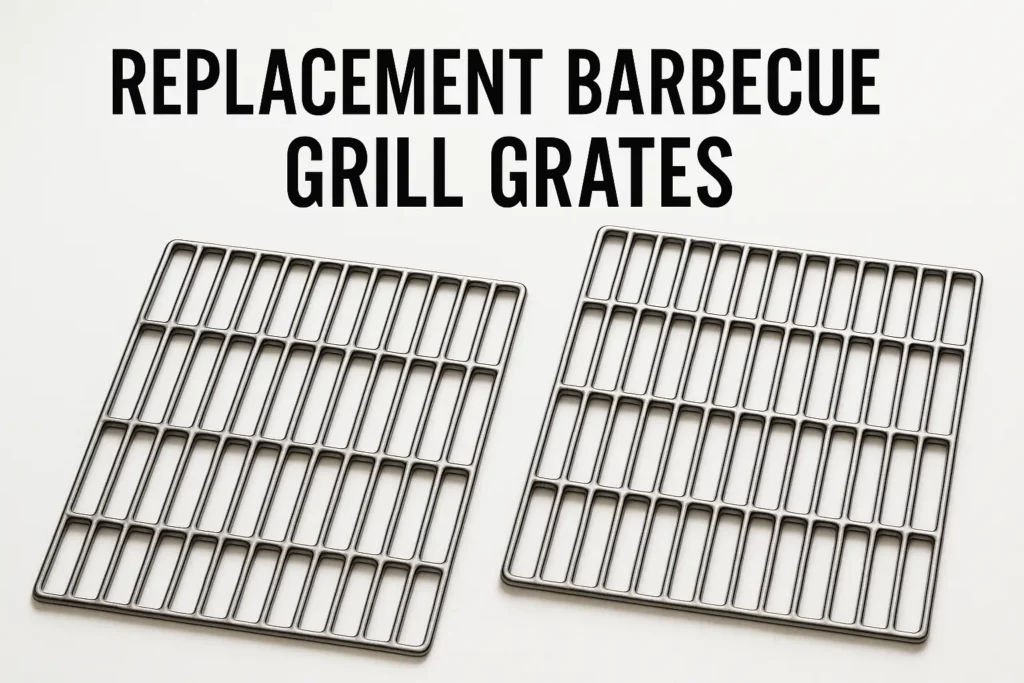This post may contain affiliate links. If you use these links to buy something we may earn a small commission. Thanks.
Whether you’re an occasional griller or a backyard BBQ master, the condition of your grill grates plays a crucial role in the quality of your food and the efficiency of your cooking. Over time, even the best grates begin to show signs of wear and tear rust, sticking, warping, or even cracking. When that happens, it’s time to consider replacing them.
This comprehensive guide will walk you through everything you need to know about replacement barbecue grill grates from understanding the different types to choosing the right one, installation, and maintenance tips.
Introduction
Grill grates are the heart of your barbecue. They’re where your food makes direct contact with the heat, and they heavily influence how it cooks, the sear marks it gets, and even how it tastes. Over time, exposure to extreme temperatures, moisture, food particles, and marinades can deteriorate grill grates.

Why should you replace grill grates?
- Better performance: New grates ensure even heat distribution and prevent food from sticking.
- Improved hygiene: Old, grimy grates can harbor bacteria and toxins from burnt food residue.
- Longer grill lifespan: A well-maintained grate protects internal grill parts from damage.
Types of Barbecue Grill Grates
1 Cast Iron Grill Grates
- 【Dimensions】 - 17" x 13 1/4" each, 17" x 26 1/2" total. 【Material】 - Matte cast iron....
- 【Fits Home Depot Nexgrill】- 4 Burner 720-0830H, 5 Burner 720-0888, 720-0888N, 720-0830X,...
- 【Replacement for Kenmore】- 122.16119, 122.16129, 122.166419, 16641, 415.1610621, 415.1610711,...
Cast iron grates are loved for their exceptional heat retention and ability to deliver professional-quality sear marks.
Pros:
- Outstanding heat distribution and retention
- Produces excellent searing
- Adds a touch of flavor with proper seasoning
Cons:
- High maintenance requires regular seasoning with oil
- Prone to rust if not maintained
- Heavy and harder to handle
2 Stainless Steel Grill Grates
- 🔥【Fits Weber Spirit 300 Series Grills】 The spirit 300 grates fits Weber Spirit E310, Spirit...
- 🔥【Fits Weber Spirit II 300 Series grills】The GS4 spirit ii 300 grates fits Weber spirit II...
- 🔥【Dimensions】Designed as a direct replacement for Weber Spirit grill grates, each grate...
Stainless steel grates are common in many modern gas grills and are known for their durability and low maintenance.
Pros:
- Resistant to rust and corrosion
- Easy to clean
- Lightweight and long-lasting
Cons:
- Heat retention is not as good as cast iron
- May warp under extremely high heat
- Doesn’t sear as well as cast iron
3 Porcelain-Coated Grates
- 【COMPATIBILITY】Product Dimensions: 17.4’’ x 11.8’’ x 0.25’’ Set of 2...
- 【APPLICATION】Replacement for Weber Genesis grill models: Genesis Silver B/C, Genesis Gold B/C,...
- 【MATERIAL】Made of porcelain-enameled replacement grates, with strong corrosion resistance & heat...
These grates are either cast iron or steel coated with porcelain enamel, combining heat retention and non-stick performance.
Pros:
- Non-stick surface makes cleaning easy
- Prevents rust (if the coating remains intact)
- Offers decent heat distribution
Cons:
- Porcelain can crack or chip over time
- Metal underneath may rust once exposed
- Avoid using metal brushes which may damage the coating
4 Chrome-Plated Grates
- 24½" diameter grill
- 3 heavy crossbars
- Constructed of quality, durable materials
A more budget-friendly option, chrome-plated grates are common in portable or inexpensive grills.
Pros:
- Affordable and lightweight
- Attractive shiny finish
- Easy to wipe clean (initially)
Cons:
- Chrome coating wears off quickly
- Vulnerable to flaking and rust
- Poor durability under frequent use
How to Know When It’s Time to Replace Your Grill Grates
Even the best grates won’t last forever. Here are some tell-tale signs that it’s time to shop for a replacement:
Rust and Corrosion
Small rust spots can often be cleaned, but if large portions of the grate are rusted or corroded, it’s better to replace than restore.
Warping or Cracks
High heat and heavy use can cause grates to warp or crack. Warped grates lead to uneven cooking and can allow small food pieces to fall through.
Excessive Food Sticking
If even properly oiled foods stick to your grates and leave behind burnt residue, the surface may be too worn down for effective cooking.
Chipped Coating
For porcelain and chrome-coated grates, visible chips expose the underlying metal, leading to rust and flare-ups.
How to Choose the Right Replacement Grill Grate
Choosing the wrong grate can lead to poor performance, wasted money, and frustration. Here’s how to get it right:
4.1 Measure Your Grill Properly
Before purchasing, measure your existing grates. Note:
- Width (side to side)
- Depth (front to back)
- Number of grates (some grills use two or three pieces side by side)
Write down these measurements in inches and double-check them against the replacement grate specs.
4.2 Match Grate Type to Cooking Style
Ask yourself:
- Do you enjoy high-heat searing for steaks and burgers? → Go for cast iron.
- Prefer easy cleanup and rust resistance? → Choose stainless steel.
- Want a balance between ease and performance? → Opt for porcelain-coated grates.
4.3 Consider Your Grill Brand and Model
Some brands (like Weber, Char-Broil, or Napoleon) offer OEM grates specifically designed for their grills. These provide a perfect fit and maintain your warranty.
Alternatively, universal grill grates can fit many models but require precise measurement to ensure compatibility.
4.4 Material Durability and Maintenance Needs
Evaluate how much time you’re willing to spend on care and cleaning. If you don’t want the hassle of seasoning or rust management, stainless steel or porcelain-coated grates might be a better choice than raw cast iron.
Top Brands and Options for Replacement Grill Grates
Here are some reliable options to consider:
Weber
Weber grates are designed specifically for Weber gas and charcoal grills. They’re available in stainless steel, cast iron, and porcelain-coated versions. Known for quality and longevity.
Char-Broil
Char-Broil replacement grates are often more budget-friendly and available at big-box stores. They offer a variety of grate materials.
Napoleon
Napoleon’s wave-shaped grill grates provide even heat distribution and stylish sear marks. They are typically high-quality and available in stainless steel or cast iron.
GrillGrate (Aftermarket Brand)
GrillGrate makes aluminum interlocking panels that sit on top of your existing grates. They improve heat distribution and reduce flare-ups while offering deep sear marks.
Universal Options
Brands like Hisencn, Hongso, and Uniflasy produce universal replacement grates that fit many grills. Ideal if you can’t find OEM grates or are looking for a more affordable option.
Installation Tips for New Grill Grates
Replacing grill grates is usually a simple task, but here are a few tips to ensure it goes smoothly:
Step 1: Remove the Old Grates
Lift out the existing grates. If they’re stuck due to rust or grease, gently loosen them with a flat tool.
Step 2: Clean the Interior
Take this opportunity to clean the interior of your grill remove old grease, ash, or debris. This enhances airflow and safety.
Step 3: Inspect the Burners and Flame Tamers
Before installing the new grates, check your burners, flame tamers, and other internal parts for wear. Replace if needed.
Step 4: Install New Grates
Place your new grates securely into the grill. Make sure they sit evenly and don’t rock or shift.
Step 5: Preheat and Season (if needed)
For cast iron or uncoated grates, lightly coat them in oil and heat for 10–15 minutes to create a non-stick surface.
Maintenance Tips to Extend the Life of Your New Grates
Taking good care of your grill grates ensures they last for many seasons.
Routine Cleaning
- After each cookout, heat the grill to high for 10 minutes to burn off food residue.
- Use a grill brush or scraper to clean the surface (use nylon for porcelain-coated grates).
Deep Cleaning (Monthly or Bi-Monthly)
- Soak grates in hot, soapy water.
- Scrub thoroughly with a sponge or non-metallic brush.
- Rinse and dry completely before reinserting.
Seasoning Cast Iron
- After cleaning, apply a thin layer of vegetable oil.
- Heat the grill to allow the oil to polymerize.
- Repeat regularly to maintain a protective coating.
Avoid Harsh Cleaners
Skip steel wool or abrasive chemicals that could damage coating or degrade the metal.
Common Mistakes to Avoid
Avoid these errors to get the most from your replacement grates:
Buying the Wrong Size
Always measure your old grates or check the manufacturer’s specifications. An ill-fitting grate can cause heat loss or food spillage.
Using the Wrong Cleaning Tools
Never use metal brushes on porcelain-coated or chrome-plated grates. It will chip the coating and reduce lifespan.
Ignoring Seasoning Needs
If you skip seasoning cast iron grates, they’ll rust quickly and lose their non-stick qualities.
Leaving Grates Exposed
Leaving your grill outside uncovered accelerates rust and wear. Use a quality grill cover when not in use.
Conclusion
Replacing your barbecue grill grates is one of the simplest and most effective ways to revitalize your grill and elevate your cooking experience. Whether you’re grilling juicy steaks, delicate fish, or a stack of veggies, the right grates make a world of difference in performance, cleanliness, and flavor.
When choosing a replacement, consider your cooking style, the type of food you prepare, and how much maintenance you’re willing to do. Invest in quality materials, follow proper installation and care techniques, and you’ll enjoy many more delicious BBQ sessions for years to come.




